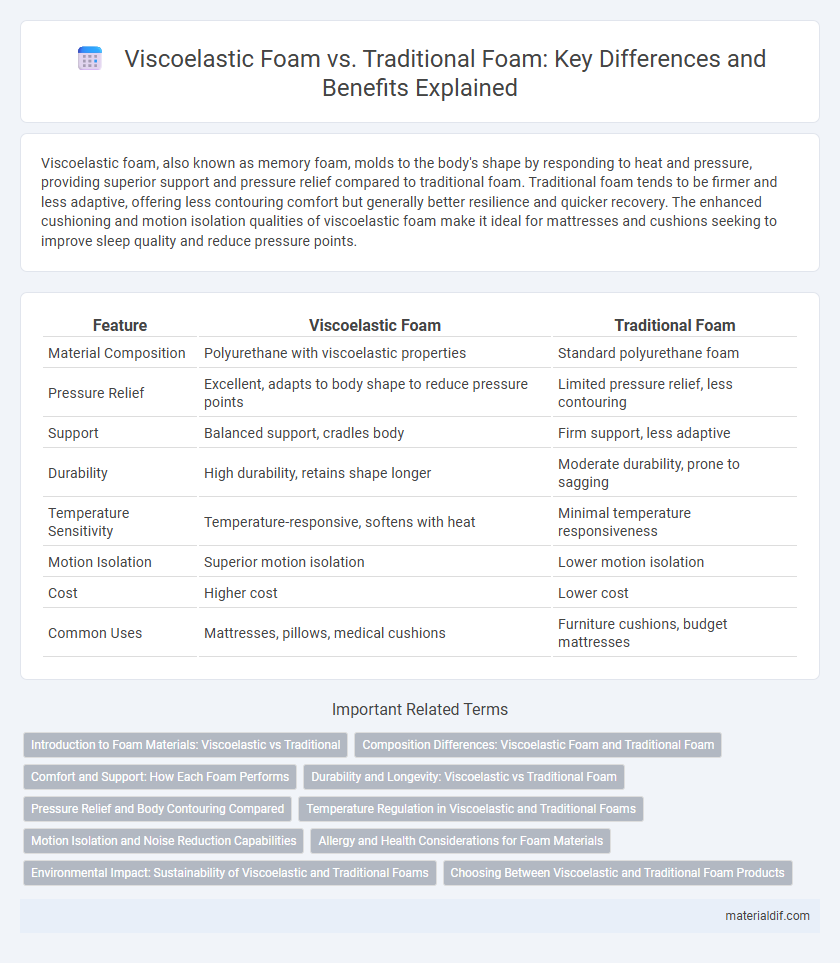Viscoelastic foam, also known as memory foam, molds to the body's shape by responding to heat and pressure, providing superior support and pressure relief compared to traditional foam. Traditional foam tends to be firmer and less adaptive, offering less contouring comfort but generally better resilience and quicker recovery. The enhanced cushioning and motion isolation qualities of viscoelastic foam make it ideal for mattresses and cushions seeking to improve sleep quality and reduce pressure points.
Table of Comparison
| Feature | Viscoelastic Foam | Traditional Foam |
|---|---|---|
| Material Composition | Polyurethane with viscoelastic properties | Standard polyurethane foam |
| Pressure Relief | Excellent, adapts to body shape to reduce pressure points | Limited pressure relief, less contouring |
| Support | Balanced support, cradles body | Firm support, less adaptive |
| Durability | High durability, retains shape longer | Moderate durability, prone to sagging |
| Temperature Sensitivity | Temperature-responsive, softens with heat | Minimal temperature responsiveness |
| Motion Isolation | Superior motion isolation | Lower motion isolation |
| Cost | Higher cost | Lower cost |
| Common Uses | Mattresses, pillows, medical cushions | Furniture cushions, budget mattresses |
Introduction to Foam Materials: Viscoelastic vs Traditional
Viscoelastic foam, also known as memory foam, is characterized by its unique ability to conform to body shape and provide pressure relief due to its temperature-sensitive viscosity and elasticity. Traditional foam, typically polyurethane foam, offers a more uniform support but lacks the contouring and slow recovery properties of viscoelastic variants. The distinct molecular structure of viscoelastic foam enhances comfort and durability, making it a preferred choice in mattresses and cushioning applications.
Composition Differences: Viscoelastic Foam and Traditional Foam
Viscoelastic foam, often called memory foam, is primarily composed of polyurethane combined with viscoelastic polymers that respond to heat and pressure, allowing it to mold to the body's shape. Traditional foam typically consists of polyurethane or latex without the added viscoelastic compounds, resulting in a more basic cushioning effect with less contouring ability. The unique chemical structure of viscoelastic foam enhances pressure relief and support, distinguishing it from the firmer and less adaptive nature of traditional foam.
Comfort and Support: How Each Foam Performs
Viscoelastic foam, also known as memory foam, adapts closely to body contours, providing superior pressure relief and personalized support that reduces discomfort and enhances sleep quality. Traditional foam offers a firmer, more consistent level of support but may lack the conforming properties that distribute weight evenly, often resulting in pressure points. The viscoelastic foam's ability to absorb motion makes it ideal for reducing partner disturbance, whereas traditional foam tends to retain shape without significant contouring, impacting overall comfort during extended use.
Durability and Longevity: Viscoelastic vs Traditional Foam
Viscoelastic foam, also known as memory foam, exhibits superior durability and longevity compared to traditional polyurethane foam due to its higher density and ability to slowly regain shape after compression. Traditional foam tends to degrade faster, losing resilience and cushioning properties within a few years of regular use. The viscoelastic properties allow memory foam to maintain structural integrity longer, making it ideal for mattresses and cushions requiring extended durability.
Pressure Relief and Body Contouring Compared
Viscoelastic foam, often known as memory foam, offers superior pressure relief by evenly distributing body weight and reducing stress on pressure points compared to traditional foam, which tends to be firmer and less adaptive. Its unique viscoelastic properties enable precise body contouring, molding closely to the body's shape and enhancing spinal alignment, unlike traditional foam that provides more generalized support. This advanced pressure mapping and conforming ability make viscoelastic foam ideal for minimizing discomfort and improving sleep quality.
Temperature Regulation in Viscoelastic and Traditional Foams
Viscoelastic foam adjusts to body heat and becomes softer, providing personalized temperature regulation, while traditional foam maintains a consistent density regardless of temperature. The open-cell structure of viscoelastic foam enhances airflow, reducing heat retention compared to the denser, closed-cell composition in traditional foam. This thermoregulatory property makes viscoelastic foam preferred for mattresses and cushions, improving comfort by minimizing overheating during sleep.
Motion Isolation and Noise Reduction Capabilities
Viscoelastic foam provides superior motion isolation by contouring closely to body movements, minimizing disturbance between sleepers, whereas traditional foam typically allows greater motion transfer. Noise reduction capabilities of viscoelastic foam are enhanced due to its dense, slow-responding structure that absorbs sound vibrations more effectively than the faster, less dense traditional foam. These properties make viscoelastic foam ideal for environments requiring quiet and undisturbed rest.
Allergy and Health Considerations for Foam Materials
Viscoelastic foam, often known as memory foam, contains open-cell structures infused with viscoelastic polymers that resist dust mites and allergens, making it an ideal choice for allergy sufferers. Traditional foam, such as polyurethane foam, tends to trap more allergens and lacks the breathability found in viscoelastic foam, which can exacerbate respiratory issues and skin sensitivities. Health considerations favor viscoelastic foam due to its hypoallergenic properties and ability to maintain a more hygienic sleeping environment.
Environmental Impact: Sustainability of Viscoelastic and Traditional Foams
Viscoelastic foam, often made from polyurethane with added chemicals, typically presents higher environmental concerns due to non-renewable resource use and longer decomposition times compared to traditional polyurethane foam. Traditional foam production also relies heavily on petrochemicals but often requires less energy-intensive manufacturing processes, resulting in a comparatively lower carbon footprint. Advances in bio-based viscoelastic foams and recycling initiatives help mitigate environmental impact, promoting greater sustainability in foam materials.
Choosing Between Viscoelastic and Traditional Foam Products
Viscoelastic foam, often known as memory foam, offers superior pressure relief and contouring by responding to body heat and weight, making it ideal for reducing pressure points and enhancing comfort. Traditional foam, while less adaptive, provides firmer support and better breathability, often at a lower cost and with quicker rebound properties. Choosing between viscoelastic and traditional foam products depends on individual needs such as desired softness, support level, heat retention, and budget considerations for mattresses or cushions.
Viscoelastic Foam vs Traditional Foam Infographic

 materialdif.com
materialdif.com